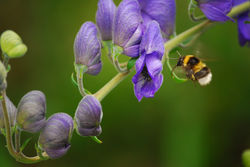How to attract pollinating insects in your garden
Green Fingers
Bridget from Caves Folly Nursery in Colwall has some ideas for making your garden more attractive to pollinating insects.
As we are nearing the end of summer, there’s a chance for a break and a chance to enjoy the garden. This is a perfect time to watch insects such as bees and butterflies. Increasing numbers of people are interested in gardening for bees and other pollinators. It really demonstrates that people care about bees, and want to do their bit to help, by providing food and habitat.
This month I want to highlight some plants to include in the garden which provide food for pollinators all through the season. Due to variations of local climate and conditions the flowering times may be different. This will affect foraging and different species.
Bumble bees, with their big fluffy coats, are often seen out on a mild winter day foraging. It is important to include early flowering plants such as Lonicera fragrantissima (winter honeysuckle), Erica carnea (winter flowering heathers), Mahonia or Snowdrops.
When selecting plants for pollinators choose the more traditional varieties with single flowers, try to avoid big double flowers.
Winter/Spring: Mahonia, Genista, Lonicera, Clematis armandii, Ribies, Cornus mas, Hamamelis, Berberis, Erica carneas, Fritillary, Scilla, Gallanthus, Primulas, Crocus.
Spring/Summer: Digitalis, Phlox, Campanula, Symphytum, Penstemon, Gaura, Salvia, Honeysuckle, Clematis, Jasminum, Echium.
Summer/Autumn: Sedum, Lythrum, Lavandula, Scabious, Hyssop, Nepeta, Oreganum, Helianthus, Monarda, Verbena, Buddleja
Autumn/Winter: Hedera, Viburnum, Cornus mas, Helleborous, Erica, Sarcococca, Mahonia, Jasminum nudiflorum.
These are just a few plants to include in your garden. Generally, a more diverse range of plants creates a better habitat.
In the nursery the large clumps of Oreganum Herrenhausen are always covered in honey bees, bumble bees and all sorts of butterflies, especially Tortoise shell and Coma. We have lots of nettle patches in the field on which the Peacock butterfly lay their eggs and we are then rewarded in summer by a Buddleja full of butterflies.
Insects such as bees provide an essential service by pollinating our crops. All over the world farmers are dependent on these little creatures to produce most of our food. With the decline of bumble bee populations, it is important that we all create a network of garden feeding stations for these amazing little creatures. So check your garden each month and monitor the bees, if there is a time with no flowers pop down to your local nursery and buy a flowering plant.
Remember not to be too ‘tidy’. Many creatures lay their eggs or overwinter in the garden, so leave piles of leaves. They can provide a habitat for overwintering butterfies such as the Coma as well as warm shelters for hedgehogs, toads, beetles and a host of other insects. Tiny bees can also overwinter in the hollow stems of plants.
Insects are a very important part of our eco system, without them we would have no soil or food!
Enjoy the last bit of summer and prepare to harvest all those fruit and vegetables for the winter.


